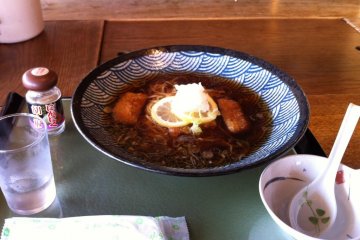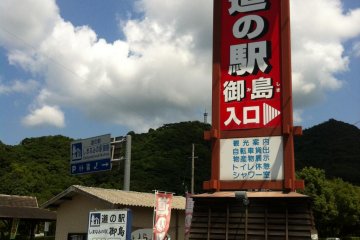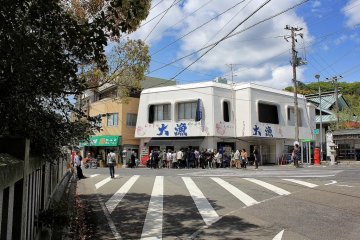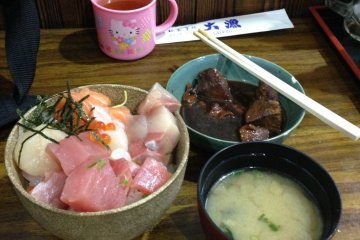If you visit Omishima island, the northernmost part of Ehime prefecture, you’d be well advised to see Oyamazumi Shrine, which holds a very important place in Japanese history. Should your visit coincide with lunchtime, your eye is likely to be drawn to a very 1970s-looking building just across the road from the entrance to the shrine. The building is painted pure white. It’s decorated with the kanji for “Tairyo” meaning “large catch” in blue, with a fish and a shrimp in red. You can also see the words “Yasui oishii”, which means “cheap and delicious”. The most conspicuous thing however is the long line of people waiting outside.
It must be said that long queues of people outside restaurants in Japan can be deceptive. Often they’re queuing because other people are queuing too. And there is an element of this at Tairyo. There are other restaurants on Omishima where you can eat well. But it’s hard to compete with the kaisen don for 380 yen. As you’re no doubt aware, the Japanese love fresh, uncooked fish, and they’re prepared to go to great lengths to get the best quality fish available. They’re especially happy if they can get it cheap. The kaisen don at Tairyo is a smallish bowl of white rice topped with a very generous quantity of raw yellow tail, tuna, squid, scallop and salmon roe. It’s unmistakably fresh, and the price is low. With some soy sauce and wasabi, applied in judicious quantities, it is very good indeed.
The kaisen don alone doesn’t make a meal, but there’s plenty else on offer at the same low prices. There are counters groaning with seafood cooked in various styles—grilled, battered, stewed, braised—all labeled with low prices, and you take whatever you please. The pleasant but eagle-eyed staff will note it down on your tab.
To get in on this feast, you have to be prepared to wait in line for at least 40 minutes, or roll up at around 10 am and put your name on the list placed in front of the restaurant. Having once baulked at the long wait, the second time I did the tactical 10 am arrival thing, and had a pleasant morning in the shrine and treasure house. It felt good crossing the road at the 11:30 opening time and going straight to the front of the queue where the lady in charge of seating was struggling to read “Walters” aloud. “Ha-ha, I can’t read this even though it’s in katakana!”, she exclaimed to general amusement.
When everybody pours into the restaurant, orders from the menu, and takes what they fancy from the counter, there are chaotic scenes of confusion, which quickly settles down to quiet satisfaction. I was driving so I was obliged to drink tea, but I fancy that a glass of the unpasteurized sake they offer would go very well with the fish.
Name in Japanese
大漁 — tairyō — Tairyo










